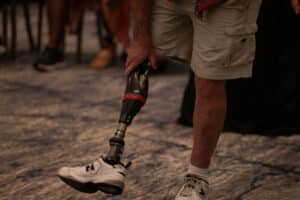By Natalie Harold, Resource Development Manager
 On Thursday, January 18, 2024, Medicare announced that the proposed changes to the Local Coverage Determination (LCD) for Lower Limb Prosthetics would cover microprocessor-controlled prosthetic knees (MPKs) and expand coverage for certain prosthetic feet for individuals with transfemoral (above-the-knee) limb loss/limb difference who are limited community ambulators (K-level 2) and meet certain medical criteria. Currently, MPKs are only available to individuals who have K-level 3 and above activity levels.
On Thursday, January 18, 2024, Medicare announced that the proposed changes to the Local Coverage Determination (LCD) for Lower Limb Prosthetics would cover microprocessor-controlled prosthetic knees (MPKs) and expand coverage for certain prosthetic feet for individuals with transfemoral (above-the-knee) limb loss/limb difference who are limited community ambulators (K-level 2) and meet certain medical criteria. Currently, MPKs are only available to individuals who have K-level 3 and above activity levels.
State of the Art: A mountain of evidence is needed to move the technologies once considered “state of the art” to become the new “standard of care”. Consider for a moment, that the first commercially available microprocessor knee in the US marketplace was the Ottobock C-leg, which was introduced 1992. In the three decades since then, the C-leg has become the most scientifically researched prosthetic device ever, paving the way for other manufacturers to innovate within this space. Nowadays, there are a lot of MPK choices offered from top manufacturers including Ottobock (C-Leg 4, Genium X3, Kenevo), Blatchford (Linx, Orion 3), Ossur (Rheo XC and Power Knee), and Proteor (Allux 2, Plié 3, Quattro). However, their prohibitively high cost and prior exclusion from most insurance coverage policies creates barriers to access for the majority of those who would otherwise benefit from their use.
State of the Science: Historically, the clinical recommendation has been to provide patients of lower ambulatory potential (K-level 2) with less expensive technology and reserve the use of more expensive technology, such as MPKs, for more active individuals. According to a systematic literature review published over a decade ago, researchers Andrew B. Sawers, PhD, CPO and Brian J. Hafner, PhD observed the potential for increased K-level when using an MPK, and concluded that patients were being denied for the very technology that would allow them to qualify for it.
Today, the mountain of empirical evidence to support this proposed LCD change is robust. It includes dozens of clinical studies, multiple systematic reviews, clinical practice guidelines, which all demonstrate the benefits of MPK technology for K-Level 2 users. Without this body of research resulting from the culmination of decades of work, this proposed change to Medicare’s LCD would not be possible.
According to Dr. Andreas Kannenberg, “this proposed change in MPK coverage for K2 patients in the Medicare LCD for Lower Limb Prosthetics is the direct result of an LCD Reconsideration Request filed by Ottobock to the DME MACs on 03/31/2022.” On March 2, 2024, the public comment period will close and the LCD will be finalized and enacted. A process which may take up to 12 months. Although we aren’t across the finish line just yet, this is a tremendous win for the members of the limb loss and limb difference community and a perfect example of the impact that research can have.

